-
Countries
-
Data and Analysis
-
Special Focus
-
Crisis Responses
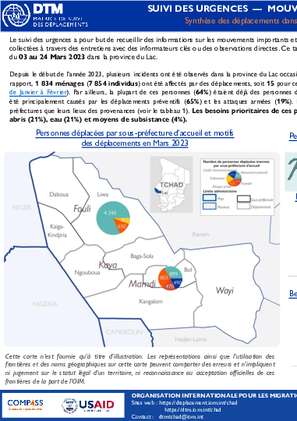
Contact
DTM Chad, dtmtchad@iom.int
Language
French
Location
Chad
Period Covered
Mar 03 2023
Mar 24 2023
Activity
- Mobility Tracking
- Event Tracking
Le suivi des urgences a pour but de recueillir des informations sur les mouvements importants et soudains de populations, ainsi que sur des urgences sécuritaires et climatiques. Les informations sont collectées à travers des entretiens avec des informateurs clés ou des observations directes. Ce tableau de bord présente les informations sur les mouvements des personnes survenus dans la période du 03 au 24 Mars 2023 dans la province du Lac.
Depuis le début de l’année 2023, plusieurs incidents ont été observés dans la province du Lac occasionnant un grand nombre de déplacements. Durant la période du 03 au 24 mars 2023 couverte par ce rapport, 1 834 ménages (7 854 individus) ont été affectés par des déplacements, soit 15 pour cent de plus comparé au mois de février 2023 couvert par le rapport synthétique précédent (ETT mensuel de Janvier à Février). Par ailleurs, la plupart de ces personnes (64%) étaient déjà des personnes déplacées avant d’effectuer ces nouveaux déplacements. Ainsi, Il est à noter que ces déplacements ont été principalement causés par les déplacements préventifs (65%) et les attaques armées (19%). En effet, la totalité des personnes se sont déplacées dans des localités situées dans les mêmes sous-préfectures que leurs lieux des provenances (voir le tableau 1). Les besoins prioritaires de ces personnes déplacées comprennent l'accès aux vivres (29%), articles non alimentaires (25%), abris (21%), eau (21%) et moyens de subsistance (4%).
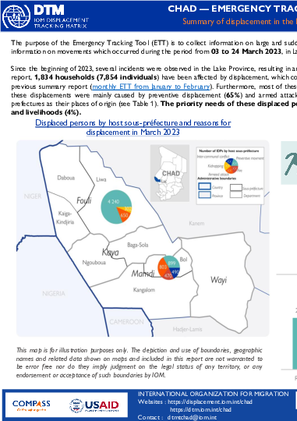
Contact
DTM Chad, dtmtchad@iom.int
Language
English
Location
Chad
Period Covered
Mar 03 2023
Mar 24 2023
Activity
- Mobility Tracking
- Event Tracking
The purpose of the Emergency Tracking Tool (ETT) is to collect information on large and sudden population movements as well as on security and climate emergencies. This dashboard provides information on movements which occurred during the period from 03 to 24 March 2023, in Lac Province.
Since the beginning of 2023, several incidents were observed in the Lake Province, resulting in an increased number of displacements. During the period from 3 to 24 March 2023 covered by this report, 1,834 households (7,854 individuals) have been affected by displacement, which corresponds to an increase of 15 per cent compared to the month of February 2023 covered by the previous summary report (monthly ETT from January to February). Furthermore, most of these people (64%) were previously displaced before these new displacements. It should be noted that these displacements were mainly caused by preventive displacement (65%) and armed attacks (19%). Indeed, all the displaced persons sought refuge to localities situated in the same sous-prefectures as their places of origin (see Table 1). The priority needs of these displaced persons included access to food (29%), non-food items (25%), shelter (21%), water (21%) and livelihoods (4%).

Contact
DTM Nigeria, iomnigeriadtm@iom.int
Language
English
Location
Nigeria
Period Covered
Mar 13 2023
Mar 19 2023
Activity
- Mobility Tracking
- Event Tracking
The DTM Emergency Tracking Tool (ETT) is deployed to track and to collect information on large and sudden population movements, provide frequent updates on the scale of displacement and quantify the affected population when needed. As a sub-component of the Mobility Tracking methodology in Nigeria, ETT utilises direct observations and a broad network of key informants to capture best estimates of the affected population per location, enabling targeted humanitarian response planning.
Between 13 and 19 March 2023, a total of 2,766 new arrivals were recorded in locations in Adamawa and Borno states. The new arrivals were recorded at locations in Askira/Uba, Bama, Dikwa, Gwoza, Kaga, Monguno, Ngala and Kala Balge* Local Government Areas (LGAs) of the most conflict-affected state of Borno and in Fufore, Gombi, Hong, Lamurde, Michika, Maiha, Mubi South, Mubi North, Numan, Yola South and Yola North LGAs of Adamawa state.
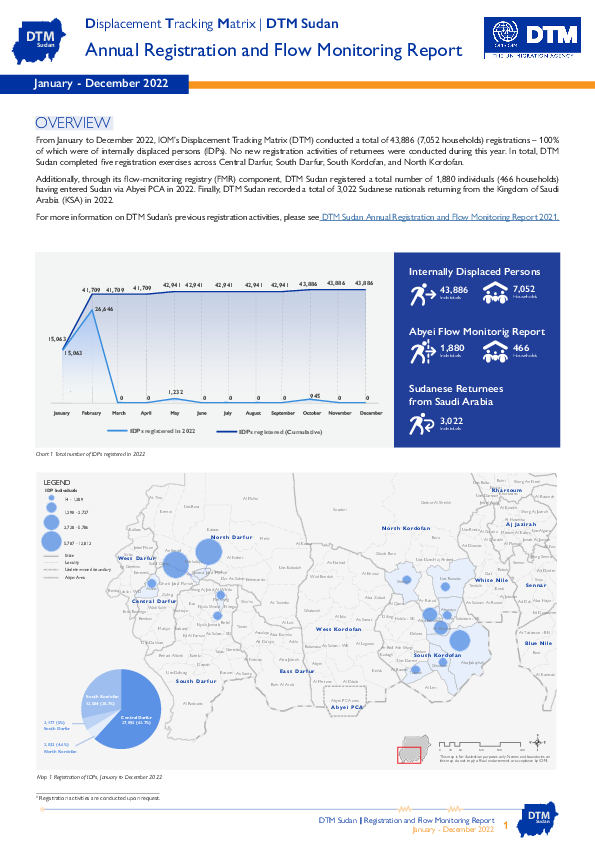
Contact
DTM Sudan, DTMSudan@iom.int
Language
English
Location
Sudan
Period Covered
Jan 01 2022
Dec 31 2022
Activity
- Registration
- Rapid Emergency Registration
- Verification for Registration
From January to December 2022, IOM’s Displacement Tracking Matrix (DTM) conducted a total of 43,886 (7,052 households) registrations – 100% of which were of internally displaced persons (IDPs). No new registration activities of returnees were conducted during 2022. In total, DTM Sudan completed five registration exercises across Central Darfur, South Darfur, South Kordofan, and North Kordofan.
Additionally, through its flow-monitoring registry (FMR) component, DTM Sudan registered a total number of 1,880 individuals (466 households) having entered Sudan via Abyei PCA in 2022. Finally, DTM Sudan recorded a total of 3,022 Sudanese nationals returning from the Kingdom of Saudi Arabia (KSA) in 2022.
IOM works with national and local authorities in order to gain a better understanding of population movements throughout Southern Africa. Through the setup of Flow Monitoring Points (FMPs), IOM seeks to quantify migration flows, trends and routes and to gain a better understanding of the profiles of observed individuals at entry, transit or exit points (such as border crossing posts, bus stations, rest areas, police checkpoints and reception centres). This report is an overview of the data collected in these FMPs from 1 to 28 February 2023.
Inter-regional migration from and within the Southern Africa is categorized along the following corridors. The Flow Monitoring Points (FMPs) were set-up in several key transit locations along the corridors to track the movements of passengers:
•Zimbabwe (Mutare) – Mozambique (Manica)
•Zimbabwe (Chirundu) – Zambia
•Zimbabwe – Botswana (Plumtree)
•Zimbabwe – South Africa (Beitbridge)
•Malawi (Mwanza) – Mozambique (Zobue)
•Malawi (Mangochi) – Mozambique
•Mozambique (Ressano Garcia) – South Africa
Over the reporting period a total of 56,178 movements were observed across 42 FMPs in the region. The Zimbabwe – South Africa corridor hosted the largest number of movements with 32,902 (59%) followed by the Malawi (Mwanza) – Mozambique (Zobue) corridor with 6,732 (12%) and the Zimbabwe (Chirundu) – Zambia corridor with 5,628 (10%) movements reported.
About Sweden
Since the start of the war in Ukraine in February 2022, IOM works to provide direct assistance to affected populations but has also provided a better understanding of individuals’ situations, aiming at improving and consolidating the crisis response efforts undertaken by IOM, governments, and the international community. IOM’s Displacement Tracking Matrix (DTM) programme seeks to understand where affected people are, their most urgent needs, and their intentions for the future.
In April 2023, the Government of Sweden has commissioned to DTM to conduct a survey with persons who left Ukraine after February 2022. The report was released in June 2023. In 2024, a second round of the survey is conducted to understand how needs and plans for the future change over time among beneficiaries of Temporary Protection in Sweden as registered by the Swedish Migration Agency (Migrationsverket).
This document is a compilation of data collected by IOM from Frontex as well as the Italian, Spanish, Greek and Maltese interior ministries on migratory movements from Africa to Europe between 2017 and 2022.
IOM works closely with a wide range of actors, including government and non-government partners, to collect and compile this data on a quarterly basis. This document presents the situation of migrant arrivals in Europe based on data for 2021 from the point of view of movements from West and Central Africa (WCA).
Data for 2022 covers the period up to December 31, 2022 (January - December 2022). These data will be regularly updated in future publications and is available on https://dtm.iom.int/europe/arrivals?type=arrivals and https://missingmigrants.iom.int/. Some data on nationalities are only partially available.
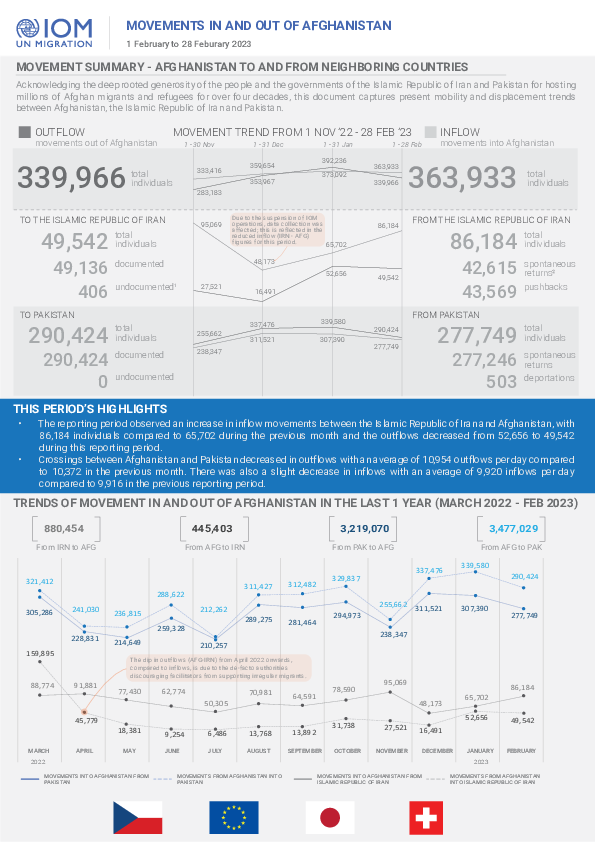
Contact
DTMAfghanistan@iom.int
Language
English
Location
Afghanistan
Period Covered
Feb 01 2023
Feb 28 2023
Activity
- Flow Monitoring
The snapshot captures present mobility and displacement trends between Afghanistan, the Islamic Republic of Iran and Pakistan.
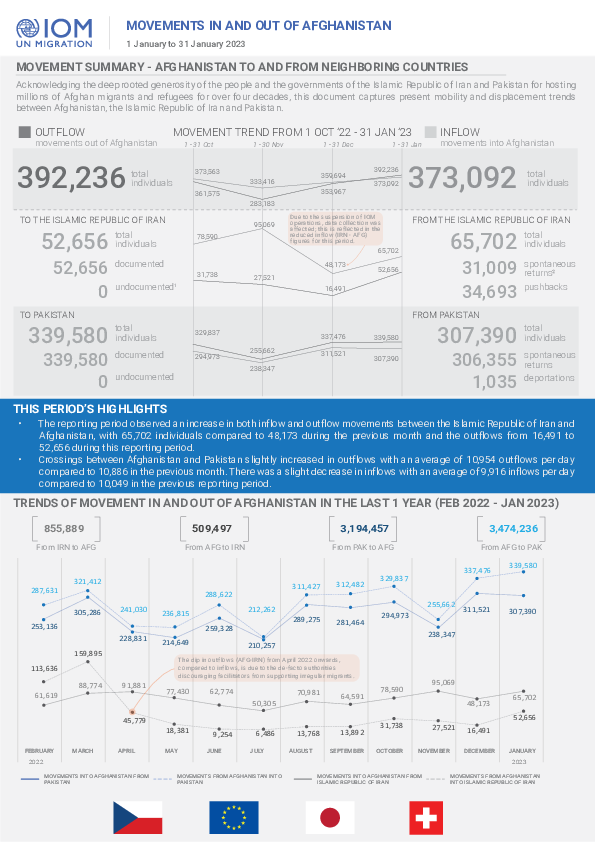
Contact
DTMAfghanistan@iom.int
Language
English
Location
Afghanistan
Period Covered
Jan 01 2023
Jan 31 2023
Activity
- Flow Monitoring
The snapshot captures present mobility and displacement trends between Afghanistan, the Islamic Republic of Iran and Pakistan.

